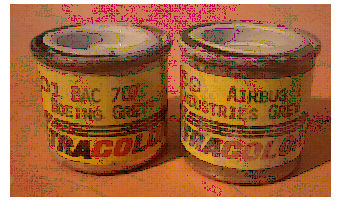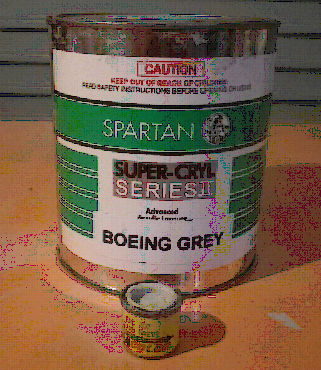(September 2013)
I’m sure it hasn’t escaped your attention, but just in case, I’ll say it again. I like to model airliners. I don’t know where this interest came from but it may go back to my childhood when my mother took my sister and I to visit her parent’s place which happened to be just to the left of the flight path of the east-west runway at Essendon Airport, on the Pascoe Vale side. The house was on the side of the hill and the bay window gave a magnificent view across the valley to the airport. I spent hours there with binoculars looking at the airliners lining up at the end of the runway; things like Viscounts, Electras, F-27s, 727s, DC-9s and the occasional international such as Super Constellations.
(My aunty who lived there thought that boats were much more interesting and thought I was being ungrateful when she dragged us down to Port Melbourne to see a boat going out. A pretty enough sight, but not aeroplanes. So perhaps I was being ungrateful at what I considered a waste of time when I could be looking at aeroplanes.)
Of course, it took me some years to get over the usual boyhood fascination with Spitfires and Messerchmitts. It might also be that it is only in the past decade or so that the popularity of resin has made it possible to make more airliners than just the standards Airfix and Revell 1/144 kits, or to make variations on what was available. This has been supplemented by several people who have been offering vacformed airliners since the 1990s. Aftermarket airliner decals have now become much more available so that it has become possible to make almost any airliner in almost any livery. So now it is possible for fans of airliners to dedicate their lives to making all the liveries that a Boeing 727-200 ever flew in, though I doubt that anyone would have a house big enough because so many airlines have flown them, even if modelled only in 1/144
The remaining challenge has been in paint. Until the 1950s airliners were almost invariable bare metal, after that they began appearing with white upper fuselages and later still with completely white fuselages while wings began appearing in protective paints. Consequently it was necessary to master the skills of painting models to replicate bare metal and to achieve good white finishes. After you’ve done that, the problem remains the protective paints on the wings.
If you happen to find yourself in modelling forums where these things are discussed you will find endless debate about what might be the correct shades of grey. The only thing I can say about these debates is that they are confused and confusing. For example, the shade of grey used by Boeing turned out to be not so much a colour but a paint composition called BAC 707. Many suggestions about an appropriate shade emerged including standard US Navy Light Gull Grey and Modelmasters Canadian Voodoo Grey. I don’t know about the Voodoo grey but I recently looked at a model of a Boeing I’d painted using Light Gull Grey some years back and it looked WRONG, too dark and too yellow. There was also the matter of the grey protective paint applied by Airbus but this seemed to bring less suggestions and remains a puzzle to me. There is also the matter of Corogard which is not so much a paint as a protective coating for wing spar boxes that is apparently metallic powder suspended in some kind of binder, which is another headache again.
The easy solution to the ‘shades of grey’ problem was provided to Xtracolor enamel paints which began producing a range of airliner colours a few years ago. They came in little tinlets, the same thing that Humbrol paints come in. If you knew where to look you could find them in the old Victorian Hobby Centre, but they aren’t in the new version of that shop. The only other reliable source was Hannants which had a complete range of colours that seemed to be as accurate as anything else, and so I relied on them for some years to provide the right colours.

Earlier this year postal authorities decided to ban the carriage of enamel paints and so my source of supply in Britain was cut off. What was I to do? I went and reread all the forum threads about realistic airliner greys again, and got myself confused again. Happily, I was in need of a specific shade of paint for an airliner I was working on and went to an automotive paint shop to see what they had. While talking to the man there it emerged that they could mix just about any shade of paint to match any examples given to them. Ah ha, I thought. Back there again I handed over my two remaining tinlets of Boeing and Airbus grey. He looked at them and didn’t laugh. ‘How much did you want?’ he asked. I had no idea but decided on getting a couple of litres of each, better to get too much than not enough. ‘Okay’, he said, ‘Come back on Friday’. I drove off thinking, ‘It can’t be that easy, can it?”
But it was that easy. When I went back he had paint cans with ‘Boeing Grey’ and ‘Airbus Industrie Gray’ labels on them. I also got a can of white and a can of thinner to thin the paint to the recommended consistency. That, and some mixing cups and a couple of other spray cans cost me a little over $300, but we amused ourselves by calculating that if I’d continued to buy my Boeing Grey in tinlets it would have cost me around $1500 to buy the same amount, just of the Boeing paint. Not a bad deal.
I had to buy some bottles to put the thinned paint in, which works out at about an additional 90cents each, and then had to go through the process of thinning and pouring this new paint into bottles, but I’m not complaining. The new paint airbrushes like a dream, dries very quickly and buffs up to what ever level of gloss I want with little fuss.
This is important. I recall clearly walking down to the food hall concourse at Melbourne Airport some time back and seeing a row of Qantas Boeing 737-800s lined up at their gates. They were all the same colours of white, grey and red but the gloss of their finished were all different, depending on how long since they had been painted, I guess. Given this new paint, I will now be able to do some experimentation with the quality of gloss that I get on my airliners. (Oh no! Is this a recurrence of the advanced case of AMS I had a decade or two ago. The doctor assured me that I was over it …)

So everything is happiness again in my modelling world. The only problem is how I’m going to use up all this paint. By the time I thin it, it makes up five litres each of Boeing and Airbus grey. I’ll have to make a lot of 747s and A380s to go through all that.